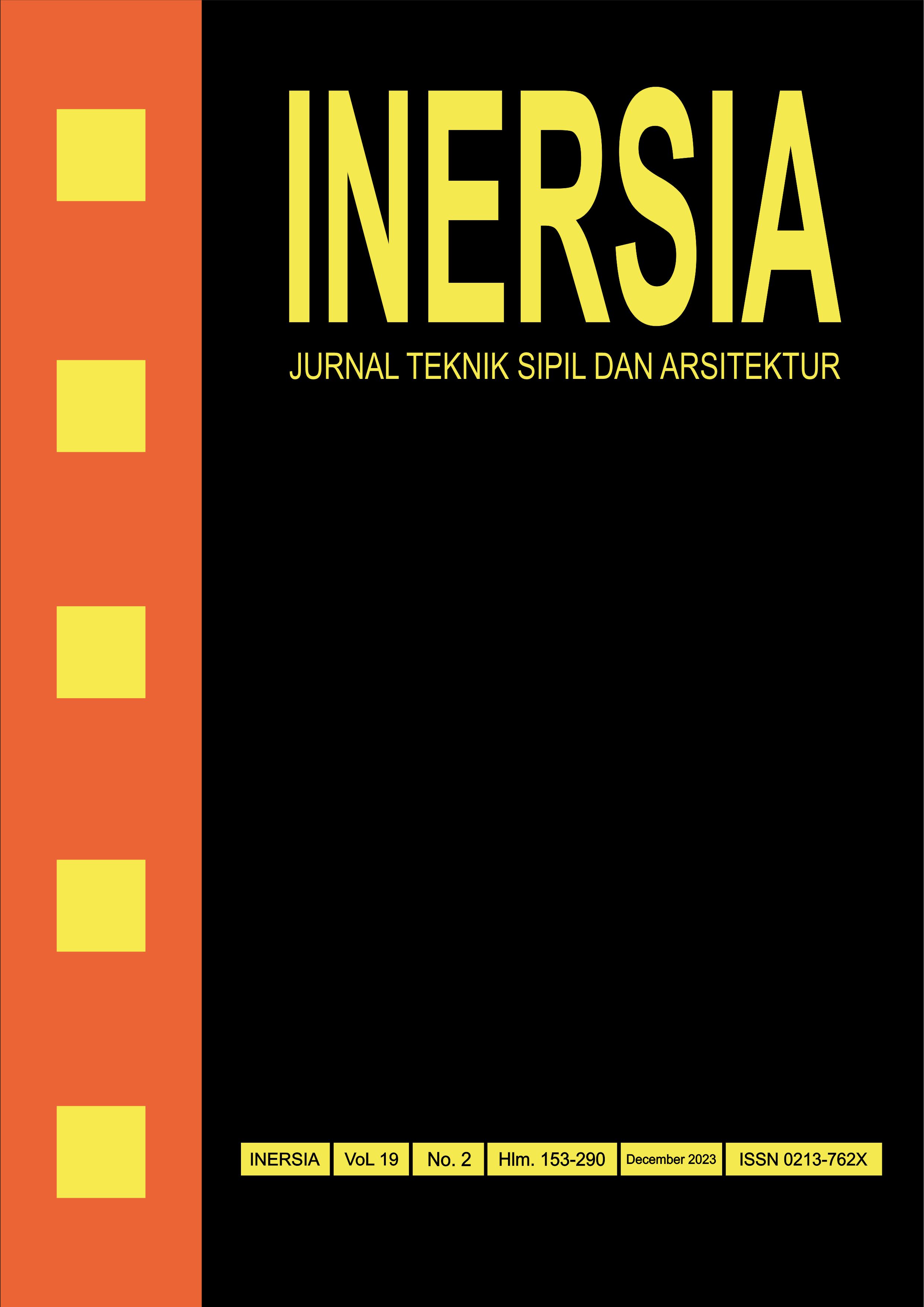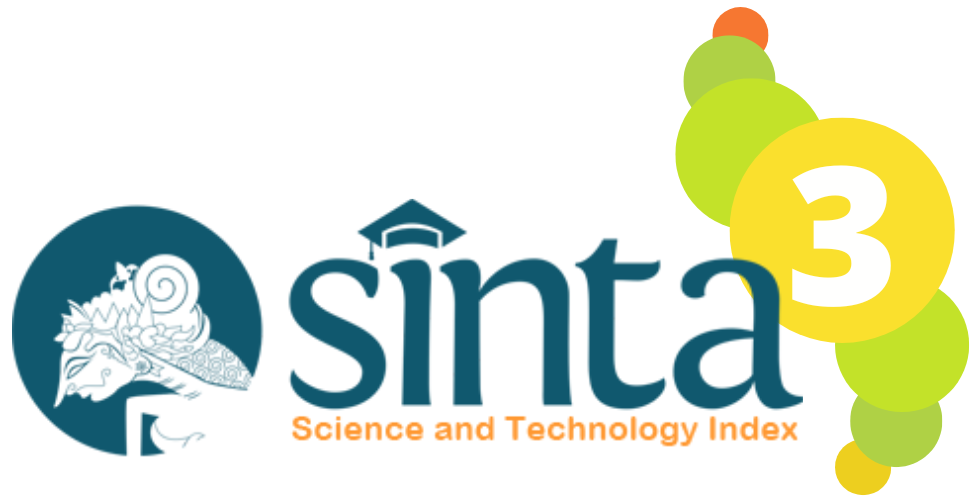Analysis of Column Compressive and Adhesive Strengths of Laminated Wood From Pine Pallet Wood Waste and Mahogany as Reinforcement
DOI:
https://doi.org/10.21831/inersia.v19i2.48410Abstract
In Indonesia, the increasing demand for wood as an industrial material and the decline in its production rate, which is usually due to illegal logging, causes the emergence of less efficient wood waste. And one of the methods for efficiently utilizing these waste is through lamination. Accordingly, lamination is a technique that involves the gluing of two or more pieces of wood together. Therefore, the purpose of this study was to determine the value of the adhesive and compressive strength of laminated columns between pine pallet waste and mahogany wood reinforcement. The adhesive strength of 20, 30, 40, and 50 MDGL variations joined together using PVAc glue, as well as the compressive strength with variations of T0 (Pine-Pine-Pine-Pine-Pine), T1 (Mahogany-Pine-Mahogany), T2 (Mahogany-Pine-Mahogany-Pine), and T3 (Mahogany-Pine-Mahogany-Pine-Mahogany) were tested in this study. Furthermore, the adhesive and compressive strength tests were in accordance with the ASTM D905-03 standard and the SNI 03-3958-1995, respectively. The adhesive strength test was carried out at the Building Materials Laboratory, Civil Engineering and Planning Study Program, and Faculty of Engineering at the Yogyakarta State University, while the compressive strength test was performed at the Structural Laboratory, Civil Engineering Department, as well as the Engineering Faculty of Tidar University. Data were then analyzed using the one-way ANOVA test and the results of each variation's adhesive strength test were 1.359 MPa, 564 MPa, 1.699 MPa, and 1.558 MPa for the 20, 30, 40, and 50 MDGL MDGL variations respectively. Furthermore, the results of the compressive strength test with variations T0, T1, T2, and T3 were 6.158 MPa, 7.366 MPa, 7.135 MPa, and 6.923 MPa respectively. It was concluded that the highest adhesive strength was at 40 MDGL and the highest compressive strength was at variation T1 (Mahoni-Pinus-Mahoni).
References
Mardikanto, Kalinasari, Bahtiar, Sifat Mekanis Kayu, Bandung: IPB Press, 2011.
E Kantieva, S Snegireva, A Platonov, "Formation of Density and Porosity of Pine Wood in a Tree Trunk," in IOP Conference Series: Earth and Environmental Science, Volume 875, International Forestry Forum "Forest ecosystems as global resource of the biosphere: calls, threats, solutions", Voronezh, Russian Federation, 2021.
Mariana D. Stanciu, Horațiu D. Teodorescu, Sorin Vlase, "Degradation of Mechanical Properties of Pine Wood Under Symmetric Axial Cyclic Loading Parallel to Grain," Polymers, vol. 12, no. 10, 2020.
Septiawan, Reza Maulana Nugroho, Naresworo Bahtiar, Effendi Tri, "Identifikasi, Pengujian Sifat Fisis Mekanis dan Analisis Fatigue Lentur Kayu Pinus," IPB University Scientific Repository, Bogot, 2020.
F. T. Wulandari, "Limbah Industri Penggergajian : Kajian dan Pemanfaatannya," Jurnal Silva Samalas, vol. 2, no. 2, pp. 75-78, 2019.
A. Saefullah, "Inovasi Desain Pemanfaatan Limbah Serbuk Kayu Yang Digunakan Untuk Meningkatkan Nilai Estetis dan Ekonomis Pada Masyarakat," Jurnal Penelitian Rumpun Ilmu Teknik, vol. 1, no. 3, 2022.
Supriyanto, "Ketahanan Alamiah Kayu Jawa Bahan Bangunan Rumah Di Pedesaan Pantai Utara Jawa Tengah Terhadap Gangguan Rayap Bawah Tanah," Jurnal PIJAR MIPA, vol. 5, no. 1, 2010.
Marek Wieruszewski, Wojciech Turbański, Katarzyna Mydlarz, Maciej Sydor, "Economic Efficiency of Pine Wood Processing in Furniture Production," Forests, vol. 14, no. 4, 2023.
Ján Iždinskí½, Ladislav Reinprecht, Zuzana Vidholdová, "Particleboards from Recycled Pallets," Forests, vol. 12, no. 11, 2021.
Murat Ozalp, Osman Percin, Suleyman Korku, "The Effect of Sea Water on Laminated Wooden Material," African Journal of Biotechnology, vol. 8, no. 8, pp. 1672-1678, 2009.
RadosÅ‚aw Mirski, Dorota Dziurka, Monika Chuda-Kowalska,Jakub Kawalerczyk, Marcin KuliÅ„ski, Karol ÅabÄ™da, "The Usefulness of Pine Timber (Pinus sylvestris L.) for the Production of Structural Elements. Part II: Strength Properties of Glued Laminated Timber," Maerials, vol. 13, no. 18, 2020.
Andi Sri Rahayu Diza Lestari, Yusuf Sudo Hadi, Dede Hermawan, "Physical and Mechanical Properties of Glued Laminated Lumber of Pine (Pinus merkusii) and Jabon (Anthocephalus cadamba)," Journal of the Korean Wood Science and Technology, vol. 46, no. 2, pp. 143-148, 2018.
M. A, "Pengaruh Jumlah Perekat Terlabur Terhadap Kuat Geser," Review in Civil Engineering, vol. 5, no. 1, 2019.
SNI-03-3958-1995, Metode Pengujian Kuat Tekan Kayu di Laboratorium, Jakarta: Badan Standarisasi Nasional, 1995.
ASTM D 905-03, "Standard Test Methods for Small Clear Specimens of Timber Annual Book of ASTM standart Vol 04.10".
SNI-03-2105-2006, Papan Partikel, Jakarta: Badan Standarisasi Nasional, 2006.
SNI-08-7070:2005, Standar Cara Uji Kadar Air Pulp dan Kayu dengan Metode Pemanasan Dalam Oven, Jakarta: Badan Standarisasi Nasional, 2005.
Downloads
Published
How to Cite
Issue
Section
License
Authors who publish with INERSIA journal agree to the following terms:
- Authors retain copyright and grant the INERSIA journal right of first publication with the work simultaneously licensed under Creative Commons Attribution License (CC BY 4.0) that allows others to share the work with an acknowledgment of the work's authorship and initial publication in this journal.
- Authors can enter into separate, additional contractual arrangements for the non-exclusive distribution of the published version of the work (e.g., post it to an institutional repository or edit it in a book), with an acknowledgment of its initial publication in this journal.
- Authors are permitted and encouraged to post their work online (e.g., in institutional repositories or on their website) before and during the submission process, as it can lead to productive exchanges, as well as earlier and greater citation of published work.

INERSIA by https://journal.uny.ac.id/index.php/inersia was distributed under a Creative Commons Attribution 4.0 International License











